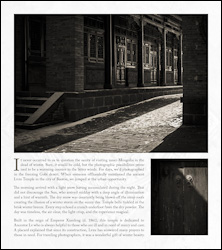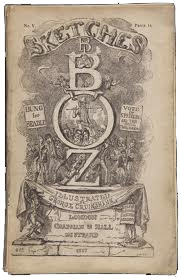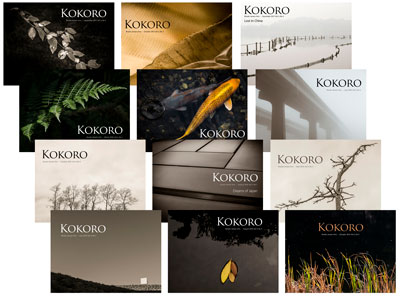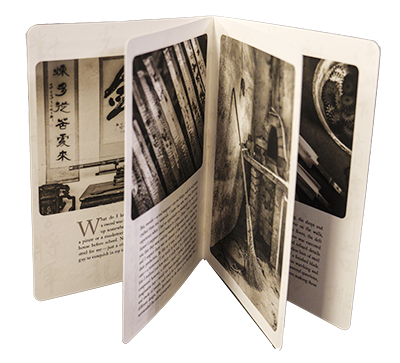About Kokoro and the Chapbooks
The world is such an incredibly fascinating place — and we live in such fortunate times to have photography to help us explore it. For decades, I've used photography as my excuse to travel, to meet people, to spend time in the most fascinating places, and to observe my little corner of the world. My earliest influences — great photographers of the West Coast tradition — all created their photographs following the methods that had been codified by Alfred Stieglitz: photography was something that was framed and hung on the wall to be seen as a visual artifact, like a painting in a gallery. The problem for me was that this was not the kind of photography I was interested in doing, but the only kind of "art photography" I knew. |
Kokoro
 Kokoro came about because of the simplest of questions: What is my artwork? That is to say, what is the most fundamental form of my work. When I was casually asked this question at a social gathering, my initial thought was images and ideas — interestingly, not photography — in particular, not prints. As I thought more about this over the following weeks, what then, I mused, is the best medium for images and ideas? If I answer prints — as I had for some 40 years — then book publications, PDFs, etc. are a supplemental format. Certainly this is how Adams, Weston, and all of their generation felt.
Kokoro came about because of the simplest of questions: What is my artwork? That is to say, what is the most fundamental form of my work. When I was casually asked this question at a social gathering, my initial thought was images and ideas — interestingly, not photography — in particular, not prints. As I thought more about this over the following weeks, what then, I mused, is the best medium for images and ideas? If I answer prints — as I had for some 40 years — then book publications, PDFs, etc. are a supplemental format. Certainly this is how Adams, Weston, and all of their generation felt.
But are prints hung on the wall the best medium for images and ideas? What if I answer publications rather than prints? My head began to spin. Years of training protested — Art goes in the gallery or the museum! Yes, I thought, except when it lives in the concert hall, or the theater, or the novel, or the stage, or in people's homes, or when recorded for television, movies, or recorded music. So, maybe only a very limited type of art lives in the gallery or the museum. I started considering seriously a new form for my photography and text, my images and ideas.
Introducing "Sketches"
Inspired by the classic book Sketches by Boz (an early pen name of Charles Dickens, one of my favorite authors), I learned that every story need not be a tale with beginning, middle, and end — nor a morality play with a "message." Just looking and seeing the world for the fascinating thing that it is can be enough. Photography was built for just such a purpose. Combined with words, a photograph can be a sketch of life just as Dickens did with his words and the accompanying drawings by Cruikshank. Why not adapt Dickens' great idea for our modern tools? Why not create sketches with a group of images and text, rather than framed wall-art of a single image?
In reviewing my photographic archives, I realized that I had thousands of small observations, moments, encounters, and experiences that are scattered throughout my photographic archive, just waiting for an ideal medium. Some are moments of wonderful light, some are portraits of interesting people, some breathtaking landscapes that inspired thought, some are simple small encounters that I hope are worth sharing. Eclectic in nature, varied in style and content, long and short, a few images or a few dozen, lengthy text or just a sentence or two, I have been working in this format for decades, unaware that I was.
Here is more about my photography and being inspired by Sketches by Boz from my audio book, Those Who Inspire Me (and Why).
And, I should add in the spirit of true confession, there is one other factor that I must acknowledge. Because I am the publisher of LensWork, it's simply not likely that any other photography magazine would ever be interested in publishing my work. I'm one of their competitors! Well, the obvious answer was to simply publish my own work — but not in LensWork because that would be tacky and so obviously self-serving. Why not create a separate publication for my personal work? It seemed the perfect answer.
Kokoro as a free ePublication
 In today's fast-paced technological world, the world-wide delivery of digital content is too important to ignore. As an artist, I've watched the iPad and other tablets quickly becoming a mainstay vehicle for viewing photography, books, and all kinds of ePublications. We know this because we publish the LensWork Tablet Edition as well as LensWork Extended and have seen it grow from a curiosity to a world-wide phenomenon.
In today's fast-paced technological world, the world-wide delivery of digital content is too important to ignore. As an artist, I've watched the iPad and other tablets quickly becoming a mainstay vehicle for viewing photography, books, and all kinds of ePublications. We know this because we publish the LensWork Tablet Edition as well as LensWork Extended and have seen it grow from a curiosity to a world-wide phenomenon.
With this in mind, Kokoro was conceived as free, downloadable PDFs which allow me to present a compilation of the content of my "sketches" to a worldwide audience, as well as to an audience for whom purchasing a physical product is not possible. Furthermore, because Kokoro is a digial publication, I'm not bound by the restrictions of physical pages.
So, in January of 2015 I began this personal compilation-style anthology publication I titled Kokoro. This is a free downloadable PDF publication, existing outside of commerce and the gallery world. As of August 2021, I've published 29 issues of Kokoro containing 151 sketches. I'm loving it and feel like I'm just getting started!
The ePublication PDF editions of Kokoro allow anyone in the world access, all for free and all in the spirit of sharing. They can be viewed on any computer using the free Adobe Reader (recommended) or other PDF viewer application. They also look great on tablets and smartphones. They are designed for landscape orientation viewing, using a 4:3 aspect ratio for tablets like the iPad or Samsung S3, but fully compatible with phones/computers/laptops, too!
Chapbooks
 I love the printed image, too! I love the hand-held experience of viewing prints up close, the intimacy that comes from touching the paper. Well, is it possible to create an art form that is part book and part photographic print?
I love the printed image, too! I love the hand-held experience of viewing prints up close, the intimacy that comes from touching the paper. Well, is it possible to create an art form that is part book and part photographic print?
For years, my answer to this question has been as the folio — a new format I pioneered and shared with thousands of photographers though my workshops, podcasts, and through LensWork. I love the folio format, but it isn't a great match for every project. I needed something else, particularly where the order of pages is critical, e.g. when there is longer-form text involved.
Enter the hand-sewn "chapbook." Derived from the "chapmen" of early England, chapbooks were originally small, pamphlet-like publications with religious tracts, political commentary, or even educational essays. In more modern times, the chapbook concept has been adopted by the art community as — typically — small, handmade book of poetry, calligraphy, or occasionally a short story. Artist-made chapbooks are a celebration of paper and handcraft. Chapbooks are the perfect vehicle for images and text to combine in an artifact that preserves the beauty of a photographic print with the design elements of layout and text. They can be a few pages in length to a dozen or more. Chapbooks are an ideal format and medium for photographs, particularly now that we photographers can produce our work on printed pages using pigment-on-paper printers. They are part book, part original print, part layout and text, part handcraft. What a wonderful way for the digital content of Kokoro to manifest in tactile materials!
My Sketches from Kokoro series of chapbooks are all 8-pages, folded and sewn, and read like a small booklet. There is a colophon page which includes provenance information — the name of the purchaser and the date it was produced. These are produced in an open edition. I print on Moab Entrada Bright White 190, a two-sided paper, using Epson inks on my Epson SureColor P700 printer. Each chapbook is produced and signed by me.
Chapbook Pricing
So much of "art-marketing" is based on hyperbole — and even downright hidden agendas and subterfuge. I've always traveled a different path — both with my personal work, and with LensWork. I've always felt it was better to be up front, candid, do the highest quality work I can, and let the chips fall where they may. Here are my thoughts about these Sketches from Kokoro series.
- Audience: As an artist, I could just do my work and store it away in the closet. Many artists do. I've always thought art is best used as a means to bring people together, to connect ideas and audience, to bridge the gaps between us all. To me, art without an audience is a tragedy.
- Dynamic: Life is movement, energy, vitality. Art need not be a dusty thing in museums. In fact, it's better if it is alive and growing. I don't want Sketches to become a pile of aging artifacts of what I did last year, on sale in perpetuity. The intent is to create a program that moves with time and dances with the creative life.
- Incentive: I am a photographer and artist — terms that I've always thought should be verbs. My incentive with this program is to provide a vehicle that encourages work and that motivates me to produce; encourages you to look, and to come back regularly to see what's new.
- Abundance: As we all know, beauty is in the eye of the beholder. You may love one project and not another. Everyone else will, too — just different ones. This Sketches program is design for breadth of titles rather than depth of inventory.
- Innovation: I am much more interested in the images and ideas than in spending hours and hours in the labor of repetitive production. Therefore, I've structured Sketches to provide incentive to new titles rather than long production runs of old titles.
- Accessible: Art should be affordable with as little financial barrier as possible. The chapbooks are priced accordingly; the PDFs are free.
- Support: Making art requires money. I offer my artwork for sale not so I can become wealthy (although I wouldn't complain about it), but rather so I can fund the next project and keep working.
The price for my printed chapbooks is $20 each. The downloadable PDF versions of Kokoro are always free.
Why $20?
Cost of paper and ink. What other handmade, original artwork can you buy for about the same price as a meal in a restaurant, a commercially published hardbound novel, a small tub of popcorn at a movie theater, or a couple of cups of coffee and a scone? Essentially, I guess it just seems like a fair price. (If you think this is too much I can only imagine your reactions to the prices in photo galleries!) And if you think $20 is too little, then I can assume you will be collecting them with regularity. :-)
Brooks Jensen
April 2020
* About the name Kokoro
Perhaps Lafcadio Hearn will not protest too much if I paraphrase (almost word for word) from Kokoro, his 1895 book of Japanese life. He explains this important Japanese term far better than I ever could:

"The entries comprising this volume treat of the inner rather than the outer life, — for which reason they have been grouped under the title Kokoro (heart). Written with the above character, this word signifies also mind, in the emotional sense; spirit; courage; resolve; sentiment; affection; and inner meaning, — just as we say in English, the heart of things."
